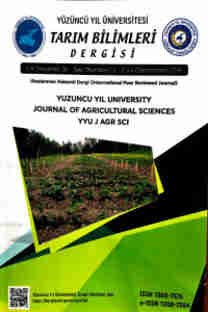Farklı sıcaklıkların scymnus subvillosus’un bıraktığı yumurta sayıları üzerine etkilerinin karışımlı poisson regresyon ile analiz edilmesi
Poisson regresyonu sayıma dayalı olarak elde edilen bağımlı değişkenin analizinde kullanılmaktadır. Poisson regresyon analizi sonucunda, verilerde aşırı yayılım saptandığında alternatif analiz yöntemlerinin kullanılması gerekmektedir. Bu çalışmada, söz konusu alternatif yöntemlerden biri olan karışımlı Poisson regresyonu incelenmiştir. Karışımlı model yaklaşımı, veri kümesinin heterojen bir yapı gösterdiğini varsaymakta ve bu heterojenliği populasyonu kendi içerisinde alt populasyonlara bölerek gidermektedir. Çalışmada, Scymnus subvillosus dişilerinin ovipozisyon süresince bıraktıkları yumurta sayıları altı alt populasyona ayrılmıştır. Uygun alt populasyon sayısını belirlemede AIC ve BIC ölçütleri kullanılmıştır. Parametre tahminleri EM yaklaşımı kullanılarak ML yöntemi ile elde edilmiştir. S. subvillosus dişilerinin ovipozisyon süresince bıraktıkları yumurta sayılarına ilişkin en yüksek değer 25°C de elde edilmiş olup onu, 20 ve 30°C’lerde elde edilen değerler izlemiştir. 35°C de elde edilen değer denemede kullanılan diğer üç sıcaklıkta elde edilenden oldukça düşük bulunmuştur.
Anahtar Kelimeler:
dağılma, Scymnus, istatistiksel analizler, regresyon analizleri, sıcaklık
Analysing the effects of different temparatures on egg numbers of scymnus subvillosus using mixture poisson regression
Poisson regression is used in the analysis of dependent variables obtained by counting. Alternative analysis methods are necessary when there is overdispersion in data as a result of Poisson regression. In the present study, one of these alternative methods, mixture Poisson regression was studied. Mixed model approaches assume when data sets is heterogeneous, and it removes the heterogeneity by dividing the population into the sub-populations. In the study, the eggs laid by Scymnus subvillosus females during oviposition were divided into six sub-populations. AIC and BIC criteria were used to the determine the suitable sub-population numbers. Parameters estimations were obtained with ML method by using EM approach. The highest egg numbers was obtained at 25°C and followed by the values obtained at 20°C and 30°C. The value obtained at 35°C was found much lower than those obtained in other three temperatures.
Keywords:
dispersion, Scymnus, statistical analysis, regression analysis, temperature,
___
- Atlıhan, R., Özgökçe, M.S., 2002. Development, fecundity and prey consumption of Exochomus nigromaculatus feeding on hyalopterus pruni. Phytoparasitica, 30(5): 443-450.
- Breslow, N., 1990. Tests of hypotheses in overdispersed poisson regression and other quasi-likelihood models. Journal of American Statistical Association, 85(410):565-571.
- Dalrymple., Hudson, I.L., Ford, R.P.K., 2002. Finite Mixture, Zero-Inflated Poisson and Hurdle Models with Application to SIDS. University of Canterbury, Christchurch, New Zealand, 19.
- Dean, C.B., 1992. Testing for overdispersion in poisson and binomial regression models. Journal of American Statistical Association, 87(418):451-457.
- Dempster, A.P., Laird, N.M., Rubin, D.B., 1977. Maximum likelihood from incomplete data via the EM Algrithm. Journal of Royal Statisticial Society, 39: 1-18.
- Jansen, R.C., 1993. Maksimum Likelihood in a Generalized Linear Finite Mixture Model by Using the EM Algorithm. Biometrics, 49(1):227-231.
- McCullagh, P., Nelder, J.A., 1989. Generalized Linear Models. Second Edition, Chapmann and Hall, London, 486.
- SAS, 2006. SAS/STAT Software:Hangen and Enhanced. SAS, Inst. Inc., USA.
- Uygun, N., Atlıhan, R., 2000. The effect of temperature on development and fecundity of Scymnus levaillanti. BioControl, 45: 453-462.
- Yeşilova, A., 2003. Biyolojik Çalışmalardan Elde Edilen Kategorik Verileri Karışık Poisson Regresyon Analizinin Uygulaması (Doktora Tezi, Basılmamış), YYÜ Fen Bilimleri Enstitüsü, Van.
- Wang, P., Puterman, M.L., Cockburn, I.M., Le, N., 1996. Mixed poisson regression models with covariate dependent rates. Biometrics, 52:381-400.
- Wang, P., Cockburn, I.M., Puterman, M.L., 1998. Analysis of patent data- mixed poisson regression model approach. Journal of Business and Economic Statistics, 16(1):27-41.
- Wang, P., Putterman, M.L., 1998. Mixed logistic regression models. Journal of Agriculture, Biological and Environmental Statistics, 3(2):175-200.
- ISSN: 1018-9424
- Yayın Aralığı: Yıllık
- Başlangıç: 2018
- Yayıncı: -
